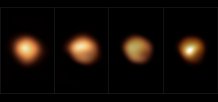articles

Betelgeuse’s surface before and during its 2019–2020 Great Dimming. Credit: ESO
Mystery behind the “Great Dimming” of the Betelgeuse star solved
The quest to discover what lay behind the “great dimming” of the aging star Betelgeuse, normally one of the brightest stars on the night sky, has taken a new, fascinating twist.
A team of international scientists, including Professor Stefan Kraus from the University of Exeter, has unravelled the mystery behind why Betelgeuse – a star in the constellation of Orion visible with the naked eye - became visibly darker in late 2019.
New research has shown that the star was partially concealed by a cloud of dust – a discovery made through a series of images taken of the star’s surface using the European Southern Observatory’s Very Large Telescope (ESO’s VLT).
The team compared an image of the star, taken in December 2019, with one from January of the same year, showing the stellar surface was significantly darker, especially in the southern region.
The team continued observing the star during its Great Dimming, capturing two other never-before-seen images in January and March 2020, before the star finally returned to its normal brightness in April.
For the new research, published today (Wednesday) in the leading journal Nature, the team revealed that the mysterious dimming was caused by a dusty veil shading the star, which in turn was the result of a drop in temperature on Betelgeuse’s stellar surface.
While Betelgeuse’s surface regularly changes as giant bubbles of gas move, shrink and swell within the star, the researchers suggest that some time before the Great Dimming, the star ejected a large gas bubble that moved away from it.
When a patch of the surface cooled down shortly after, that temperature decrease was enough for the gas to condense into solid dust.
Professor Kraus said: “Aging stars such as Betelgeuse have long been suspected to churn out flecks of dust, either through a constant wind or more localised surface ejections. Here, we see that Betelgeuse has ejected a massive dust cloud that has obscured half of the stars surface while drifting away into space.”
The team used the Spectro-Polarimetric High-contrast Exoplanet REsearch SPHERE instrument on ESO’s VLT to directly image the surface of Betelgeuse, alongside data from the GRAVITY instrument on ESO’s Very Large Telescope Interferometer, to monitor the star throughout the dimming.
Miguel Montarges, lead author of the study from the Observatoire de Paris, France, and KU Leuven, Belgium added: “For once, we were seeing the appearance of a star changing in real time on a scale of weeks. We have directly witnessed the formation of so-called stardust.”
Rather than just the result of a dusty outburst, there was some speculation that Betelgeuse’s drop in brightness could signal its imminent death in a spectacular supernova explosion.
A supernova hasn’t been observed in our galaxy since the 17th century, so present-day astronomers aren’t entirely sure what to expect from a star in the lead-up to such an event.
However, this new research confirms that Betelgeuse's Great Dimming was not an early sign that the star was heading towards its dramatic fate.
Emily Cannon, from KU Leuven, who was also involved in the study added: “Looking up at the stars at night, these tiny, twinkling dots of light seem perpetual. The dimming of Betelgeuse breaks this illusion.”
Date: 16 June 2021
